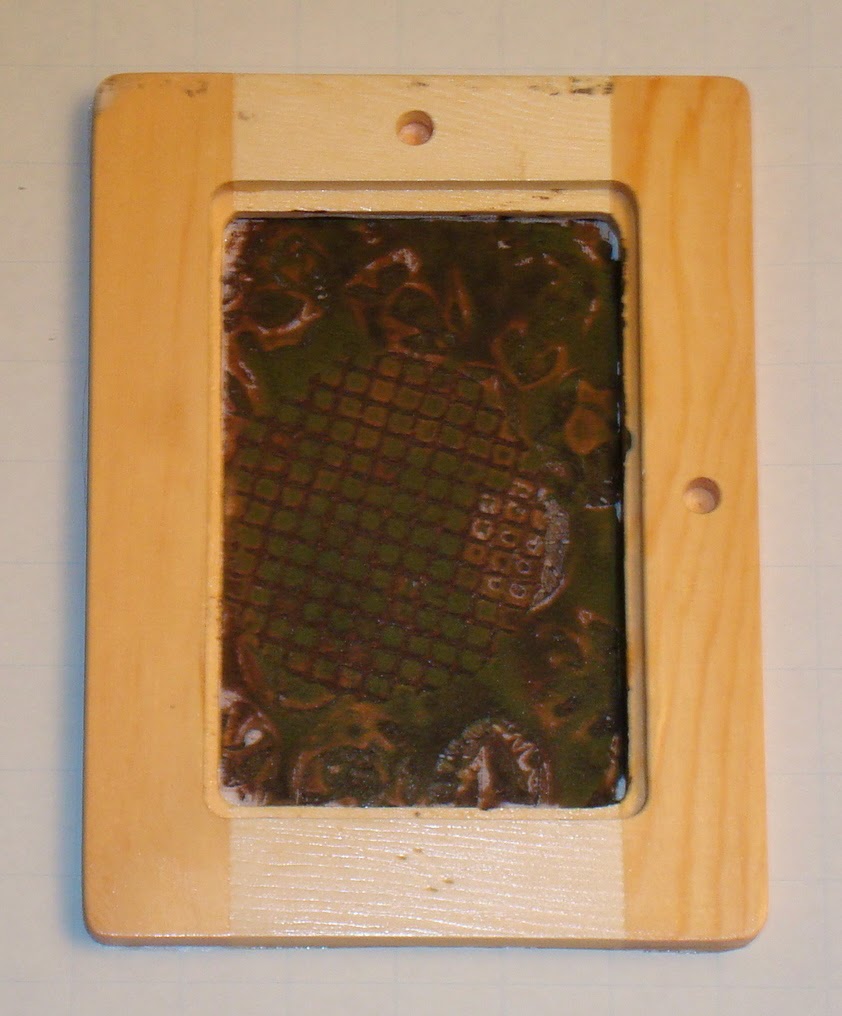This screen is turned upside down to allow the dye to dry on the screen - never let acrylic paint dry on your screen or it is a goner. But dye is always soluble in water or in release paste which is just water thickened with sodium alginate. The cloth has been pre-soaked in soda water solution (9 tbls to 1 gal of water) and allowed to dry naturally.
The cloth is stretched and pinned onto a print board which has some padding. I use doubled corrugated cardboard covered in batting, then covered in clear vinyl tablecloth protector. All of that is just duct taped on the back securely. Mine have lasted for years.
This handwoven cloth was double woven on the loom and slits were strategically planned. The soft sculpture was slid onto a clear tube for display. This didn't make the cut for a weaving competition, but I really enjoyed the whole process.
The frames below were canvas covered wooden stretchers and I removed the little rubber gasket that holds the canvas on the back. I tried using it to hold the "silk" screen fabric which is actually polyester, but it was too slippery. Screens have to be tight as drums in my opinion or it's too hard to lift them off the cloth after each pull. They stick and you can ruin your image trying to lift it off.
For this one, I just taped the back and the edges to cover the edge of the screen fabric. No little gutter on the front. Since I don't wash these I don't worry about the water running under the edge from the front.
Here's an in-process shot of gluing the screen fabric onto the wooden frame. Sorry for the messiness of these process shots, I took them mostly to remind myself which glue I used. Several I tried were not reliable.
You can see the orange screen fabric taped down to the table. The frame (with the glue applied liberally edge to edge, but not messily, to the back) is being pressed down with bricks. I covered four bricks with fabric for my daughter's wedding since we weren't sure if it would rain or not. I had an arch covered with rushed fabric and twining ivy. Outside we could just poke the poles in the ground. But if we had moved the ceremony inside because of bad weather, I planned to use the bricks on the dance floor for the arch. As it turned out the bricks weren't used, her wedding day was perfect. The bricks have come in handy over the last fourteen years as clean weights for all kinds of projects.
Another one of my double-woven deconstructed screen prints, say that ten times fast! This is a detail, I love the way the weave adds texture to the color of the dye. I put a tape measure on the cloth and placed a commercial cotton next to it. It's a sample from a eco/contact print that just happened to be handy. Looking at the thread counts - in my handwoven, it's about 16 ends per inch compared to at least 200 for quilter's cotton. It's a difference in resolution, a lot like reducing the pixels in a photo blurs the photo somewhat.
Too bad I didn't print from that screen on some commercial cotton for a better comparison but at the time, I had no idea I would be rambling so much about the process here on the Fire blog. Since this is deconstructed screen printing, that screen is exhausted and no way I can reproduce the exact image again unless I print the photo image onto fabric with my Epson printer. Now that would make an interesting composition - combining the handwoven with the digital print.
The double woven cloth is still pinned on the print board. I have yet to dye the other side - there's a piece of plastic between the two layers - so it's still virgin cloth on the reverse. Waiting for inspiration on what will go with this. That's my story and I'm sticking to it. But the digital print / handwoven mash-up is sounding like a good way to go. I may even do some selective unweaving of the cloth to go with the deconstructed printing. Deconstructed Deconstruction would be a perfect title.
Here's the screen before printing.
And several screens I've made that have only minimal taping.
Thanks for following along this month. Hope you'll try making a screen for deconstructed screen printing.Diane - yarngoddess














Diane,
ReplyDeleteWhich brand of glue did you feel performed the best?
L
Good stuff and I like you sculpture
ReplyDeleteThis is fascinating. So often we are encouraged to use 'flat' fabric for printing, but the extra texture of the handwoven is a wonderful direction to head in!
ReplyDeleteSandy in the UK
Thanks, Sandy! It is a bit of a departure but natural for me with so many looms and so much handwoven available.
ReplyDeleteDiane
Interesting texture bases make for more exciting dyed pieces, brilliant idea to use hand woven fabric, the possibilities are endless
ReplyDeleteI like the additional texture that the handwoven fabric gives and the vessel is gorgeous. I really love the long skinny piece.
ReplyDelete